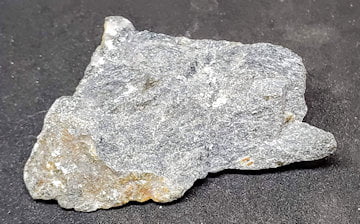Arizona Gold Ore
With a gold ore that we’re talking about here it’s usually super fine gold and well dispersed throughout the quarts.
Therefore, even is super powerful metal detector design for gold we usually not signal from normal gold ore. But, there are many exceptions when the fine gold is concentrated within the quartz vein or has actually formed a nugget with in the quarts.
Arizona Gold Ore

So, should you come across a quartz blowout, that showing reddish or iron staining, it would definitely pay to run your detector over this material! Who knows, you could actually strike a new gold vein!
From Wikipedia, the free encyclopedia:
Ore is natural rock or sediment that contains one or more valuable minerals, typically containing metals, that can be mined, treated and sold at a profit. Ore is extracted from the earth through mining and treated or refined, often via smelting, to extract the valuable metals or minerals. The grade of ore refers to the concentration of the desired material it contains. The value of the metals or minerals a rock contains must be weighed against the cost of extraction to determine whether it is of sufficiently high grade to be worth mining, and is therefore considered an ore.
Minerals of interest are generally oxides, sulfides, silicates, or native metals such as copper or gold. Ores must be processed to extract the elements of interest from the waste rock. Ore bodies are formed by a variety of geological processes generally referred to as ore genesis.
Gold extraction refers to the processes required to extract gold from its ores. This may require a combination of comminution, mineral processing, hydrometallurgical, and pyrometallurgical processes to be performed on the ore.
In 1887, John Stewart MacArthur, working in collaboration with brothers Dr Robert and Dr William Forrest for the Tennant Company in Glasgow, Scotland, developed the MacArthur-Forrest Process for the extraction of gold ores. By suspending the crushed ore in a cyanide solution, a separation of up to 96 percent pure gold was achieved.
Gold mining from alluvium ores was once achieved by techniques associated with placer mining such as simple gold panning and sluicing, resulting in direct recovery of small gold nuggets and flakes. Placer mining techniques since the mid to late 20th century have generally only been the practice of artisan miners. Hydraulic mining was used widely in the Californian gold rush, and involved breaking down alluvial deposits with high-pressure jets of water. Hard rock ores have formed the basis of the majority of commercial gold recovery operations since the middle of the 20th century where open pit and or sub-surface mining techniques are used.
Once the ore is mined it can be treated as a whole ore using a dump leaching or heap leaching processes. This is typical of low-grade, oxide deposits. Normally, the ore is crushed and agglomerated prior to heap leaching. High grade ores and ores resistant to cyanide leaching at coarse particle sizes, require further processing in order to recover the gold values. The processing techniques can include grinding, concentration, roasting, and pressure oxidation prior to cyanidation.
0 Comments